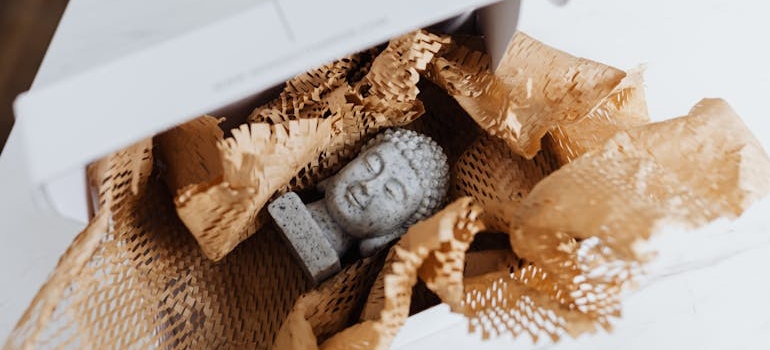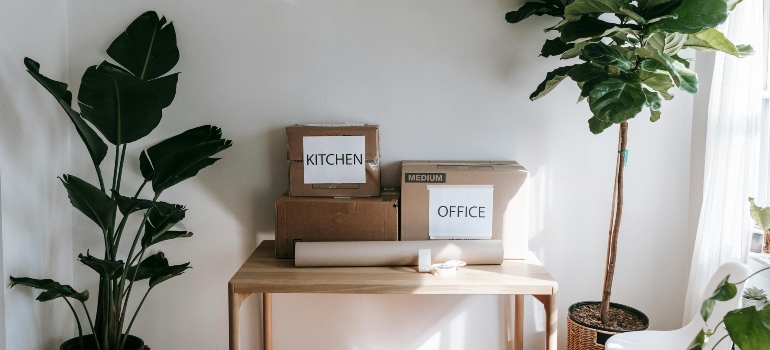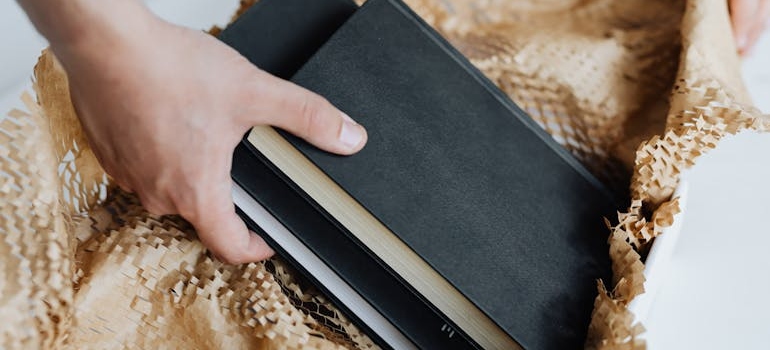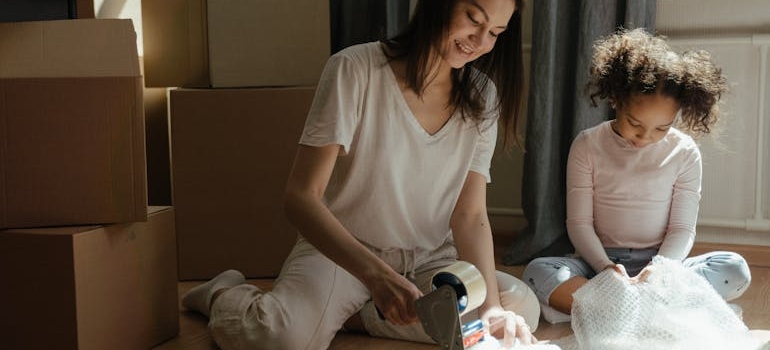The Ultimate Guide on How to Pack for Moving House in Idaho
The path to a fresh beginning after moving your Idaho home is paved with bubble wrap, boxes, and a bit of stress—especially when it comes to packing. The goal of having everything safely wrapped, delivered, and unpacked is surmountable! However, it requires you to follow a detailed Peasley Moving & Storage guide on how to pack for moving house in Idaho quickly, properly, and timely. So, allow our guide to demystify the packing process for various household items, providing clear, step-by-step strategies everybody can apply. Let’s turn packing into an opportunity for a smooth transition!
Essential Packing Categories for a Smooth Move
Moving house requires careful planning and packing of a wide range of items. To help you prepare, here’s an exhaustive list of items you’ll need to know how to pack effectively for your move. Each category and item is tailored to ensure the safety and organization of your belongings during the moving process.
- Dishes, Glasses, China, Silverware, Pots, Pans, and Small Appliances: Use dividers and bubble wrap to secure and cushion these items within boxes.
- Mirrors, Picture Frames, Artwork, and Fine Glassware: Employ bubble wrap and specialized boxes for each piece to prevent movement and absorb shocks.
- TVs, Monitors, Computers, and Small Electronic Devices: Detach all cables, use original packaging where possible, or wrap in anti-static bubble wrap.
- Jewelry, Books, Toys, Clothes: Utilize small containers for jewelry and vacuum-seal bags for clothes to save space and prevent damage.
- Lamps, Lampshades, and Vinyl Records: Wrap lamp bases and shades separately, and keep vinyl records upright in sturdy moving boxes in Boise to avoid warping.
- House Plants: Place in plastic pots and secure in boxes with air holes, keeping them upright and stable.
- Furniture, Mattresses, Bedding, and Outdoor Equipment: Dismantle furniture where possible, cover mattresses and furniture with protective sheets, and wrap sharp edges.
- Knives, Tools, and DIY Equipment: Wrap knives individually, secure toolboxes, and cushion heavy equipment in bubble wrap.
Categorizing items before a move simplifies both the packing and unpacking process, ensuring you can easily locate and manage your belongings. This methodical approach also maximizes the protection of your items, tailored to the specific needs of each category, leading to a smoother transition to your new home.

General Packing Tips
Starting your packing process with a clear plan can significantly ease the stress of moving. Begin by decluttering, removing anything you no longer use or need; this reduces your load and can even save on moving costs. Invest in quality packing materials, including sturdy boxes, packing supplies Boise offer like bubble wrap, and packing tape, to protect your belongings.
Labeling each box with its contents and intended room in the new house streamlines both loading and unloading, ensuring items are easily found and placed where they belong. Additionally, packing a separate essentials box with items you’ll need immediately upon arrival—like toiletries, a few dishes, and bedding—avoids unnecessary searching through boxes on your first night.
Detailed Packing Guides
Each item in your home, from the smallest piece of jewelry to the largest piece of furniture, requires its own approach to ensure it arrives safely at your destination. Understand the right materials to use, the best techniques for wrapping, and the most effective ways to secure items in boxes or moving trucks as it can make all the difference.
How to Pack Dishes for Moving
When packing dishes for moving, start by lining the boxes with bubble wrap or packing paper for cushioning. Wrap each dish individually, then stack them vertically like records, which minimizes pressure on the dishes and reduces the risk of breakage.
Within this context, also consider how to pack plates for moving, employing the same careful wrapping and vertical stacking technique for optimal protection. In case you wonder how to pack dishes for moving without paper, instead of paper, use foam pouches for each dish or plate. It is providing a cushioning layer that’s both protective and environmentally friendly.
How to Pack China for Moving
To safely pack china for moving, each piece should be wrapped individually in soft packing paper, and bubble wrap should be used for extra protection. Plates can be stacked on their edges in a box lined with crumpled paper for cushioning. This method is similar when considering how to pack glassware for moving, emphasizing the need for individual wrapping and the use of compartment boxes to prevent clinking and potential damage.
How to Pack Glasses for Moving
When packing glasses for moving, individual wrapping is key. Use packing paper inside each glass to maintain shape and wrap the outside with bubble wrap. For wine glasses, extra padding is necessary due to their stems. Discussing how to pack wine glasses for moving, use specialized dividers in your boxes to keep them from knocking into each other and provide additional protection.
How to Pack Knives for Moving
Securely pack knives for moving by wrapping each one individually in packing paper, then in bubble wrap. Place the wrapped knives in a sturdy box, separating them with cardboard dividers. Clearly label the box to prevent accidents. This care ensures sharp items are safely transported without injury.
How to Pack Books for Moving
Packing books for a move requires choosing the right size box to avoid overloading. Stand books upright or lay them flat, alternating the spine and edges to distribute weight evenly. This method protects the books’ spines and makes the box easier to carry. Knowing how to pack for moving house in Idaho properly involves taking good care of your library, too!

How to Pack Clothes for Moving
For packing clothes for moving, wardrobe boxes are ideal because they allow clothes to be moved on hangers directly from closet to box, reducing wrinkles. Vacuum seal bags are great for out-of-season clothes, saving space and protecting garments from moisture and pests. Additionally, consider how to pack clothes when moving in suitcases to maximize space and minimize boxes.
How to Pack Bedding for Moving
Bedding can be used to cushion other items during the move or packed separately in vacuum seal bags to save space. Ensure that bedding is clean and dry before packing to prevent mold and mildew. You can use arge, labeled plastic bags or boxes for easy identification and unpacking.
How to Pack a Mattress for Moving
Protect your mattress by wrapping it in a specialized mattress bag that shields against dirt, moisture, and damage. Secure the bag with tape and, if possible, transport the mattress flat or on its side but properly supported to avoid bending.
How to Pack Furniture for Moving
Dismantle furniture pieces if possible, wrapping and labeling each part. Protect furniture surfaces with moving blankets or bubble wrap and secure with packing tape. For non-dismantlable items, use corner protectors and furniture pads to prevent scratches and dents during the move. Finally, when you arrive, opt for furniture installation services and have your pieces immediately ready for a well earned rest.
How to Pack Jewelry for Moving
Small jewelry items are easily lost or tangled during a move. To pack jewelry for moving, use egg cartons or pill organizers for earrings and rings. When it comes to how to pack necklaces for moving, one effective method is to thread each necklace through a drinking straw and fasten the clasp, which keeps them straight and tangle-free. For necklaces too thick for straws, lay them flat on a small towel, roll the towel gently, and secure it with rubber bands.
Alternatively, if you need to know how to pack for moving house in Idaho with numerous bracelets and necklaces, you can use plastic wrap technique. Lay the necklaces on a sheet of plastic wrap, place another sheet over them, and press around each necklace to seal it in place, keeping them separated. Place your prepared necklaces in a jewelry box or a small container, and fill any empty spaces with soft packing material to prevent movement.
How to Pack Electronics for Moving
Electronics require special care due to their sensitivity and value. Unless you have Boise office movers by your side, begin by backing up important data and removing batteries to prevent leaks. Use original boxes when possible, or pack each item in anti-static bubble wrap and place them in sturdy boxes filled with packing peanuts or foam. For how to pack monitors for moving, ensure the screen is protected with a layer of foam or bubble wrap, and the box is tightly sealed and marked as fragile.
Packing a TV requires a sturdy box ideally the original box with foam inserts. If you don’t have the original box, and wish to know how to pack tv for moving wrap it in a thick blanket or bubble wrap and secure it in a box with plenty of padding. This approach is vital specifically how to pack a TV for moving without box, ensuring the screen and electronics are protected.

How to Pack Artwork for Moving
When it comes to how to pack artwork for moving, wrap each piece in acid-free paper followed by bubble wrap for cushioning. Use a picture box that fits the artwork snugly, filling any gaps with packing paper to prevent movement. The same principle applies to how to pack framed art for moving, with additional caution around the glass.
If you wonder how to pack large pictures for moving, wrap them in moving blankets and secure with plastic wrap. Custom wooden crates are ideal for extremely valuable or large items to provide maximum protection. Mark these items as fragile and ensure they are loaded onto the moving truck last to avoid pressure from other items.
How to Pack Mirrors for Moving
Packing mirrors for moving requires special attention to prevent cracks or breaks. First, tape an ‘X’ across the mirror surface to help absorb shock. Wrap the mirror in bubble wrap and place it in a flat, padded box. Securely label the box as fragile to ensure careful handling. This same care you should apply if you wonder how to pack picture frames for moving, especially those with glass components, to protect them during the move.
How to Pack a Lamp for Moving
Remove the bulb and shade, wrapping them separately. Wrap the base in bubble wrap or a blanket, securing it with tape. If possible, disassemble the lamp to save space. Box the base and shade separately, filling any gaps with packing material to prevent movement.
Once it comes to how to pack lampshades for moving, you should pack them separately from their bases, using boxes that fit them closely without squishing. Fill the box with soft packing material to avoid crushing the shade. Lampshades, especially those made of delicate materials or with intricate designs, require careful handling to maintain their shape.
How to Pack Vinyl Records for Moving
One of the fragile items you need to consider when learning how to pack for moving house in Idaho are your vinyls. Keep vinyl records upright in sturdy, small-to-medium-sized boxes to prevent warping. Place cardboard dividers between records for additional support, and consider wrapping rare or valuable records in plastic sleeves for extra protection from dust and moisture.
How to Pack Plants for Moving
To pack plants for moving, first prune any dead leaves or branches to reduce stress on the plant. Place each plant in a plastic pot to avoid breakage and cover the soil with plastic to retain moisture. Secure the plant in a box with holes for air and label the box with the plant’s name and “this side up” instructions. This ensures your green friends remain healthy and upright throughout the move.
How to Pack Toys for Moving
If you wonder how to pack Legos for moving, consider securing sets in individual zip-lock bags or wrapping larger built pieces in cling film to maintain their structure. Place these in a larger box cushioned with packing peanuts or bubble wrap. This method minimizes the chance of losing pieces and keeps your sets organized.

How to Pack Tools for Moving
For packing tools, start by gathering all hand tools, garden tools, and power tools. Clean them to prevent transferring dirt and debris to your new location. Wrap sharp tools like saws or shears in bubble wrap or towels to prevent injury when unpacking after moving to Idaho. Power tools should have their batteries removed and packed separately.
For smaller hand tools, use toolboxes or wrap them in bundles with stretch wrap. You can pack larger tools into sturdy boxes, with heavier items at the bottom and lighter tools on top, filling gaps with packing material to prevent shifting. Label each box clearly with its contents and “heavy” if applicable, to ensure safe handling
How to Pack a Moving Truck
Strategically packing a moving truck is crucial for maximizing space and ensuring the safety of your belongings. Start with the heaviest furniture against the front wall of the truck. Layer lighter boxes on top of furniture and secure them with straps. Place fragile items last, ensuring they won’t be crushed.
This detailed guidance on how to pack for moving house in Idaho not only protects your belongings but also maximizes space and minimizes the risk of damage, providing a smoother moving experience. Whether you’re dealing with fragile glassware or cumbersome electronics, knowing how to pack each item properly is key to a successful relocation!

